Culture foundlings
For more than 5,000 years people have settled in the what is today's Lüneburg Heath Nature Park. From the materials they found in this landscape, they created houses and stables, churches and tombs.
The "Culture foundlings" hiking trail invites you to follow in the footsteps of this culture. The path leads through homely heathland villages with thatched houses and stables and leads you to the outstanding historical cultural and art sites of the Heath. In the villages of Südergellersen, Betzendorf, Soderstorf, Raven, Egestorf or Hanstedt, you will find centuries-old half-timbered houses, ornate Treppenspeicher granaries, historic churches with erratic boulder foundations, and the typical detached towers. With Oldendorf Totenstatt and Soderstorf megalith you discover the most impressive relics of protohistoric settlement. In Oldendorf Archaeological Museum you can see how people lived 5000 years ago and how they built their mighty tombs.
A sparkling diamond of modernity is Bossard Site of Arts near Jesteburg. Between 1911 and 1950 the artist couple Johann and Jutta Bossard created a total work of art that is characterized by expressionism, combining painting, architecture, sculpture and gardening.
Megaliths and burial mounds
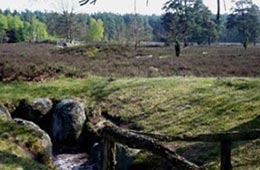
Foto: Hans-Georg Sievers
In Lüneburg Heath Nature Park, numerous remnants of Stone Age and Bronze Age burial sites testify to more than 5000 years of settlement. During the hike through the heathland and the forest you can always see striking, flat, round hills: these are burial mounds, dating from 2,500 to 1,100 BC. There are more than a thousand of them in the Nature Reserve alone.
The megaliths are most impressive. In Eyendorf, for example, mighty erratic boulders form a burial chamber which has been used several times over the centuries. Ensembles of several megaliths can be found in Oldendorf Totenstatt and in the necropolis of Soderstorf. They are among the most fascinating testimonies of early history in Lüneburg Heath Nature Park. The megaliths are up to 80 metres long and have several entrances.
The heathland village
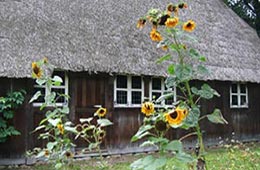
A typical heathland village is characterized by its open, scattered settlement structure with land-intensive heathland management. Since each farm required ten times as much heathland as arable land, the individual farmsteads often lay far apart. Only smaller farms concentrated around villages.
The farms in heathland villages were surrounded by fields and gardens, and often by a copse of oaks and beeches. This small forest served as fire protection, provided wood, and pigs and cattle were fattened in it. Drystone walls surrounded the courtyards or limited land.
The historical heathland farm
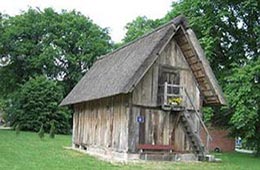
Fotos: Bispingen Touristik e.V.
The centre of each farm were the residential buildings, where people and cattle lived under one roof. The dominating space of the reed-roofed houses was the large hall. Between the living quarters and the hall lay the open kitchen in which an open hearth was burning. The smoke passed through the roof and protected it from vermin.
A heathland farm also included a number of outbuildings such as stables, storage buildings and barns. Particularly noteworthy are the wooden, two-storey Treppenspeicher granaries, which are richly decorated. The upper floor is accessible via an external staircase on the gable side.
Package "Hiking without luggage"
Start in Jesteburg, 6 nights in Jesteburg, Hanstedt, Egestorf, Soderstorf, Betzendorf and Lüneburg.
Services:
6 x B&B, packed lunch, luggage transfer, hiking map, entrance to Bossard Site of Arts and Oldendorf Archaeological Museum, price: from €450.
Booking
Nature Park Information Office, Bispingen
Bispingen-Touristik e.V.
Bahnhofstr. 19
29646 Bispingen
Tel. 05194 987 969-0
Fax 05194 987 969-7
E-Mail info@bispingen-touristik.de
Web www.bispingen-touristik.de
Nature Park Information Office, Schneverdingen
Schneverdingen-Touristik
Rathauspassage 18
29640 Schneverdingen
Tel. 05193-93800
Fax 05193-93890
E-Mail touristik@schneverdingen.de
Web www.schneverdingen-touristik.de
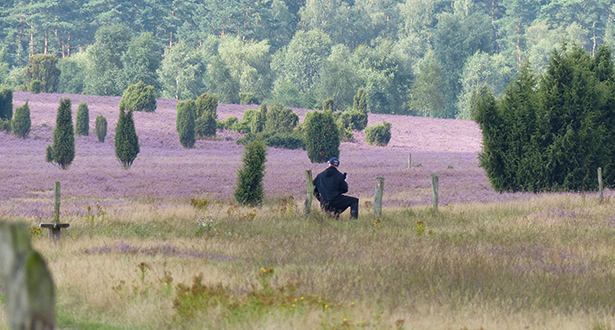
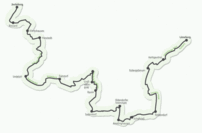
![[Translate to Englisch:] Siegel: Europäische Union – Europäischer Fond für regionale Entwicklung.](/fileadmin/_processed_/d/6/csm_europaeische-union-fond-regionale-entwicklung-logo_50eda43563.gif)
![[Translate to Englisch:] Logo Europa für Niedersachsen.](/fileadmin/_processed_/b/e/csm_europa-fuer-niedersachsen-logo_7b3947c73c.gif)
![[Translate to Englisch:] Logo Leader.](/fileadmin/_processed_/c/5/csm_leader-logo_c9a57e9ee0.gif)
![[Translate to Englisch:] Siegel: Europäische Union – Europäischer Landwirtschaftsfond für die Entwicklung des ländlichen Raums.](/fileadmin/_processed_/4/7/csm_europaeischer-landwirtschaftsfond-logo_ce24e54bf4.gif)
![[Translate to Englisch:] Logo touristischer Partner Lüneburger Heide.](/fileadmin/_processed_/4/3/csm_lueneburgerheide_positiv-mit-schatten_logo_00411b91a8.gif)